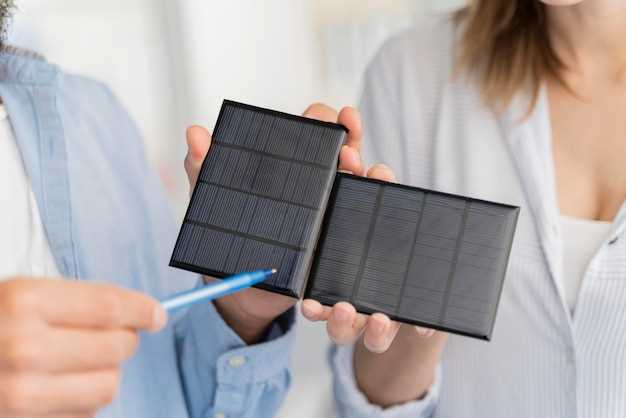
Renewable energy sources have become increasingly important in today’s world, as countries strive to reduce their dependence on non-renewable resources and combat the effects of climate change. One such promising source is solar power, which harnesses sunlight and converts it into usable electricity. In this article, we embark on a journey into the fascinating realm of photovoltaic technology, delving into the fundamental principles that underlie the conversion of solar energy into electrical power.
At its core, photovoltaic technology is centered around the concept of generating electricity from sunlight. Unlike other forms of energy generation that rely on finite resources or complex processes, solar power offers a clean, abundant, and sustainable alternative. By utilizing specially designed materials, known as photovoltaic cells, solar panels are able to directly convert sunlight into electrical energy, without the need for mechanical generators or fuel consumption.
Imagine a world where our energy needs can be met simply by harnessing the power of the sun. Through the strategic placement of solar panels across vast landscapes, homes, and even mobile devices, solar power has the potential to revolutionize the way we generate and consume electricity. The simplicity and versatility of this conversion process, coupled with the immense energy-generating capacity of the sun, make solar power a highly promising avenue for meeting our growing energy demands in a sustainable and environmentally friendly manner.
In the following sections, we will delve deeper into the underlying principles of photovoltaic technology, exploring the unique properties of solar cells, the process of converting sunlight into electrical energy, and the various factors that influence solar power generation. By gaining a better understanding of these concepts, we can begin to appreciate the immense potential that solar power holds for transforming our energy landscape and creating a brighter, more sustainable future.
Understanding Photovoltaic Technology: Harnessing the Power of the Sun
Exploring the potential of solar energy holds the key to unlocking a sustainable and clean source of power. In this section, we delve into the fascinating world of photovoltaic technology, which enables the conversion of sunlight into usable electricity. This innovative technology harnesses the immense power of the sun, offering numerous benefits and possibilities for energy generation.
At its core, photovoltaic technology involves the use of solar cells, which are made up of semiconductor materials. These materials have unique properties that enable them to absorb photons from sunlight and convert them into electrical energy through a process called the photovoltaic effect. This remarkable phenomenon allows for the direct conversion of sunlight into electricity, providing a renewable and abundant source of power.
Photovoltaic systems consist of interconnected solar panels that capture sunlight and convert it into direct current (DC) electricity. An inverter then transforms the DC electricity into alternating current (AC), which can be used to power our homes, businesses, and even entire communities. This technology has the potential to reduce our dependence on non-renewable energy sources and significantly contribute to the fight against climate change.
| Benefits of Photovoltaic Technology: |
|---|
| 1. Renewable Energy Source |
| 2. Environmentally Friendly |
| 3. Energy Independence |
| 4. Cost Savings |
| 5. Long-Term Investment |
As we continue to explore photovoltaic technology, we will delve deeper into the science behind solar energy conversion and the various components that make up a photovoltaic system. We will also examine the practical applications and potential challenges associated with this technology, as well as its role in shaping a sustainable and clean energy future.
Exploring the Fundamentals of Harnessing Solar Power
In this section, we will delve into the essential principles of capturing the abundant energy emitted by the sun and converting it into usable electricity. We will explore the core concepts and mechanisms involved in solar energy conversion, shedding light on the fundamental processes that make solar power a sustainable and renewable energy source.
Solar energy conversion encompasses a series of intricate yet elegant mechanisms that allow us to tap into the immense power of the sun. Through the utilization of advanced technologies, we are able to harness sunlight and transform it into electricity that can power our homes, businesses, and even entire communities.
- Understanding Photovoltaic Cells: At the core of solar energy conversion lies the photovoltaic (PV) cell– a remarkable device that converts photons from the sun into an electrical current. We will examine the working principles of PV cells, exploring the intricate interplay between semiconductor materials, electron movement, and the production of electricity.
- Exploring Solar Panels: Solar panels, comprised of interconnected PV cells, play a vital role in the conversion process. We will delve into the structure and function of solar panels, discussing their arrangement, efficiency, and the factors influencing their performance. By understanding the essential components of solar panels, we can appreciate their role as key elements in solar energy conversion systems.
- Examining System Integration: While PV cells and solar panels are integral components, their optimal performance relies on system integration. We will explore the crucial aspects of system design, including the selection of inverters, batteries, and other components that facilitate the efficient conversion and storage of solar energy.
- Considering Environmental Impact: As we explore the basics of solar energy conversion, it is essential to address the environmental impact of this technology. We will examine the sustainability and benefits of solar energy, including reduced greenhouse gas emissions, the mitigation of climate change, and the potential for energy independence.
- Looking Ahead: As solar energy conversion continues to evolve, we will explore emerging technologies and future advancements in this field. From multi-junction solar cells to innovative materials, we will discuss the potential breakthroughs that could revolutionize solar energy conversion and shape the future of renewable energy.
By gaining a comprehensive understanding of the basics of solar energy conversion, we can appreciate the immense potential and significance of this renewable energy source. Through exploration and knowledge, we can contribute to the ongoing advancements in solar technology and pave the way for a cleaner and more sustainable future.
Unleashing Solar Energy: The Role of Photovoltaic Technology
Solar power has emerged as a revolutionary source of renewable energy, transforming our world and offering a sustainable alternative to traditional energy sources. At the heart of this solar revolution lies photovoltaic technology, a remarkable innovation that harnesses the power of sunlight and converts it into electricity. In this section, we will explore the pivotal role that photovoltaic technology plays in unleashing the full potential of solar energy.
Advancing Technology for Solar Harvesting
In order to maximize the capture and utilization of solar energy, photovoltaic technology has constantly evolved and improved over the years. Through continuous research and development, scientists and engineers have been able to enhance the efficiency of solar cells, allowing for greater energy conversion rates and higher power output. This technological progress has not only increased the effectiveness of solar energy systems but has also made them more cost-effective and accessible to a wider range of applications.
Empowering Sustainable Energy Solutions
The widespread adoption of photovoltaic technology has revolutionized the global energy landscape by enabling the generation of clean, renewable energy on a large scale. Solar power has the potential to meet a significant portion of our energy needs while drastically reducing our dependence on fossil fuels and mitigating the adverse effects of climate change. The versatility of photovoltaic technology allows for its integration into various systems, including residential, commercial, and even utility-scale power generation, further promoting sustainable energy solutions on a global scale.
| Advantages of Photovoltaic Technology | Challenges and Future Prospects |
|---|---|
| – Renewable and abundant energy source | – Improving energy conversion efficiency |
| – Minimal environmental impact | – Reducing manufacturing costs |
| – Low maintenance requirements | – Integrated energy storage solutions |
As we delve deeper into the intricacies of photovoltaic technology, we will gain a comprehensive understanding of its mechanisms, applications, and potential for shaping a sustainable future powered by solar energy.
Understanding How Solar Cells Convert Sunlight into Electricity
Solar cells are fascinating devices that harness the power of sunlight to generate electricity. These innovative devices undergo a complex process that allows them to convert light energy into usable electrical energy. In this section, we will explore the intricate mechanisms behind solar cell operation and gain a deeper understanding of how they efficiently convert sunlight into electricity.
The Physics of Solar Cell Operation
At the heart of every solar cell lies the semiconductor material, typically made of silicon, that plays a crucial role in the conversion process. When sunlight reaches the solar cell, it is comprised of tiny particles of energy called photons. These photons interact with the semiconductor material, causing the electrons in the material’s atoms to gain energy and become excited. The excited electrons then begin to move, creating an electric current that can be harvested as electricity.
The Role of the Photovoltaic Effect
The central principle in solar cell operation is the photovoltaic effect, which describes the process of converting light energy into electricity through semiconductors. This effect occurs when the excited electrons move through the semiconductor material, creating a flow of electrons from one end of the solar cell to the other. By utilizing carefully engineered layers of different materials, solar cells can maximize the efficiency of this process and generate more electricity from the incoming sunlight.
Understanding how solar cells convert sunlight into electricity is fundamental to realizing the full potential of solar energy as a renewable source. By harnessing the power of the sun, these innovative devices contribute to a sustainable future by providing clean and reliable electricity for various applications.
The Science behind Photovoltaic Technology: The Inner Workings of Solar Cells
Solar cells, the fundamental component of photovoltaic technology, have an intricate process that enables them to convert sunlight into electricity. Understanding the science behind these solar cells is crucial in comprehending the inner workings of solar energy conversion.
At the heart of solar cells are semiconductors, materials that have properties that lie between those of insulators and conductors. When sunlight, composed of particles called photons, hits the surface of a solar cell, it excites the electrons present in the semiconductor. This excitation results in the creation of electron-hole pairs, which are responsible for generating an electric current.
The electron-hole pairs are separated within the solar cell through the utilization of a built-in electric field. This field is created by the junction formed between two layers of different semiconductor materials. The electric field causes the electrons to migrate to one side of the cell, while the holes move to the opposite side. This separation of charges creates a voltage difference, which in turn generates an electric current.
In order to facilitate this charge separation process, solar cells are often coated with a thin layer of antireflective material. This coating allows for increased sunlight absorption, maximizing the number of photons that can interact with the semiconductor material. Additionally, solar cells are equipped with a grid of metal lines that act as electrical contacts, allowing the extracted electricity to be directed towards an external circuit.
While solar cells operate on the principles of the photoelectric effect, their inner workings are much more complex. Factors such as the choice of semiconductor material, the design of the cell, and the environmental conditions can all influence the efficiency and performance of solar cells. In order to harness the full potential of photovoltaic technology, ongoing research and advancements in the science behind solar cells are vital.
By delving into the intricate details of how solar cells function, we can gain a deeper understanding of the inner workings of photovoltaic technology. This knowledge is crucial in furthering our ability to harness the power of solar energy and contribute to a more sustainable future.
Diving into the Principles of Electron Movement and Energy Conversion
Understanding the intricate mechanisms behind electron movement and energy conversion is crucial when delving into the world of solar energy. In this section, we will explore the fundamental principles governing the flow of electrons and the transformation of solar energy into usable electrical power.
Exploring Electron Movement
Electron movement lies at the heart of photovoltaic technology, driving the conversion of sunlight into electricity. Electrons, which are negatively charged particles, possess the ability to move within certain materials, creating an electrical current. During the process of solar energy conversion, photons from the sunlight excite electrons in the semiconducting material of a photovoltaic cell, causing them to break free from their atoms and form an electron-hole pair.
The freed electrons are then drawn towards the negative terminal of the cell, following an electrical circuit, while the remaining holes, which are positively charged, move towards the positive terminal. As the electrons flow through the circuit, they can power electronic devices or be stored in batteries for later use.
Evaluating Energy Conversion
Energy conversion is a significant aspect of photovoltaic technology, as it dictates the efficiency and effectiveness of solar panels. The primary goal is to maximize the conversion of solar energy into electrical energy while minimizing losses due to heat or other forms of energy dissipation.
Several factors influence the efficiency of energy conversion, including the materials used in the photovoltaic cells, the design of the solar panel, and external conditions such as temperature and sunlight intensity. By understanding these principles and optimizing their interplay, scientists and engineers can continuously enhance the performance of solar energy systems.
| Factor | Impact on Energy Conversion Efficiency |
|---|---|
| Material Selection | Determines the ability to absorb and release electrons |
| Solar Panel Design | Affects the surface area available for sunlight capture |
| External Conditions | Influences the overall energy output based on temperature and sunlight intensity |
By comprehending the fundamental principles of electron movement and energy conversion, we can appreciate the intricacies of solar energy technology and its potential to revolutionize our energy production and consumption patterns.
Types of Photovoltaic Cells: From Crystalline Silicon to Thin-Film Technologies
Within the realm of solar energy conversion, there exists a rich diversity of photovoltaic cells. These cells, which serve as the foundation for harnessing the power of the sun, employ various technologies to convert sunlight into usable electrical energy. In this section, we will explore the different types of photovoltaic cells, ranging from the widely used crystalline silicon cells to the innovative thin-film technologies.
Crystalline Silicon Cells
Crystalline silicon cells, often referred to as monocrystalline or polycrystalline cells, make up a significant portion of the photovoltaic market. These cells are manufactured using high-purity silicon in a crystalline form, offering excellent efficiency and durability. Monocrystalline cells, characterized by their uniform composition and high cost, deliver the highest efficiency levels. On the other hand, polycrystalline cells are more cost-effective and distinguishable by their grain-like appearance.
Thin-Film Technologies
In contrast to crystalline silicon cells, thin-film technologies represent a newer generation of photovoltaic cells. These cells are made using ultra-thin layers of various semiconductor materials, such as cadmium telluride (CdTe), copper indium gallium selenide (CIGS), and amorphous silicon (a-Si). Thin-film technologies offer advantages including lower manufacturing costs, flexibility, and the ability to be integrated into a variety of surfaces. However, they generally exhibit lower conversion efficiencies compared to crystalline silicon cells.
- Cadmium Telluride (CdTe) Cells: CdTe cells are known for their excellent absorption properties, making them efficient at converting sunlight into electricity. They are commonly used in large-scale utility projects due to their cost-effectiveness and stability.
- Copper Indium Gallium Selenide (CIGS) Cells: CIGS cells possess a high absorption coefficient, enabling them to capture a large portion of solar radiation. These cells are known for their flexibility, making them suitable for applications that require curved or irregular surfaces.
- Amorphous Silicon (a-Si) Cells: a-Si cells are characterized by their non-crystalline structure, which allows for a more cost-efficient manufacturing process. While they have lower efficiency levels compared to other types of cells, a-Si cells perform well under low-light and high-temperature conditions.
Understanding the different types of photovoltaic cells is crucial for selecting the most suitable technology for specific applications. Each type offers a unique set of advantages and limitations, making solar energy conversion a diverse and rapidly advancing field.
Comparing the Efficiency and Cost-effectiveness of Different Solar Cell Materials
In this section, we will explore the varying levels of efficiency and cost-effectiveness offered by different materials used in the production of solar cells. We will analyze and compare the performance and economic considerations associated with these materials, providing a comprehensive understanding of their strengths and limitations.
1. Efficiency
Efficiency plays a crucial role in determining how effectively a solar cell converts sunlight into electrical energy. We will examine the efficiency levels achieved by various materials, such as silicon, thin-film technologies (including amorphous silicon, cadmium telluride, and copper indium gallium selenide), and emerging alternatives like perovskite materials. By evaluating their efficiency performance, we can gain insights into the most viable options for maximizing energy output.
2. Cost-effectiveness
Cost-effectiveness is an essential consideration in the adoption of solar cell materials, as it influences the overall affordability and return on investment of solar energy systems. We will analyze the cost factors associated with different materials, including the production processes, raw material availability, scalability, and market demand. By understanding the cost-effectiveness of each material, decision-makers can make informed choices when investing in solar energy technology.
In conclusion, this section will provide a comprehensive examination of the efficiency and cost-effectiveness aspects of various solar cell materials. By understanding the strengths and limitations of these materials, individuals and organizations can make informed decisions when selecting the most suitable solar cell material for their energy needs.


